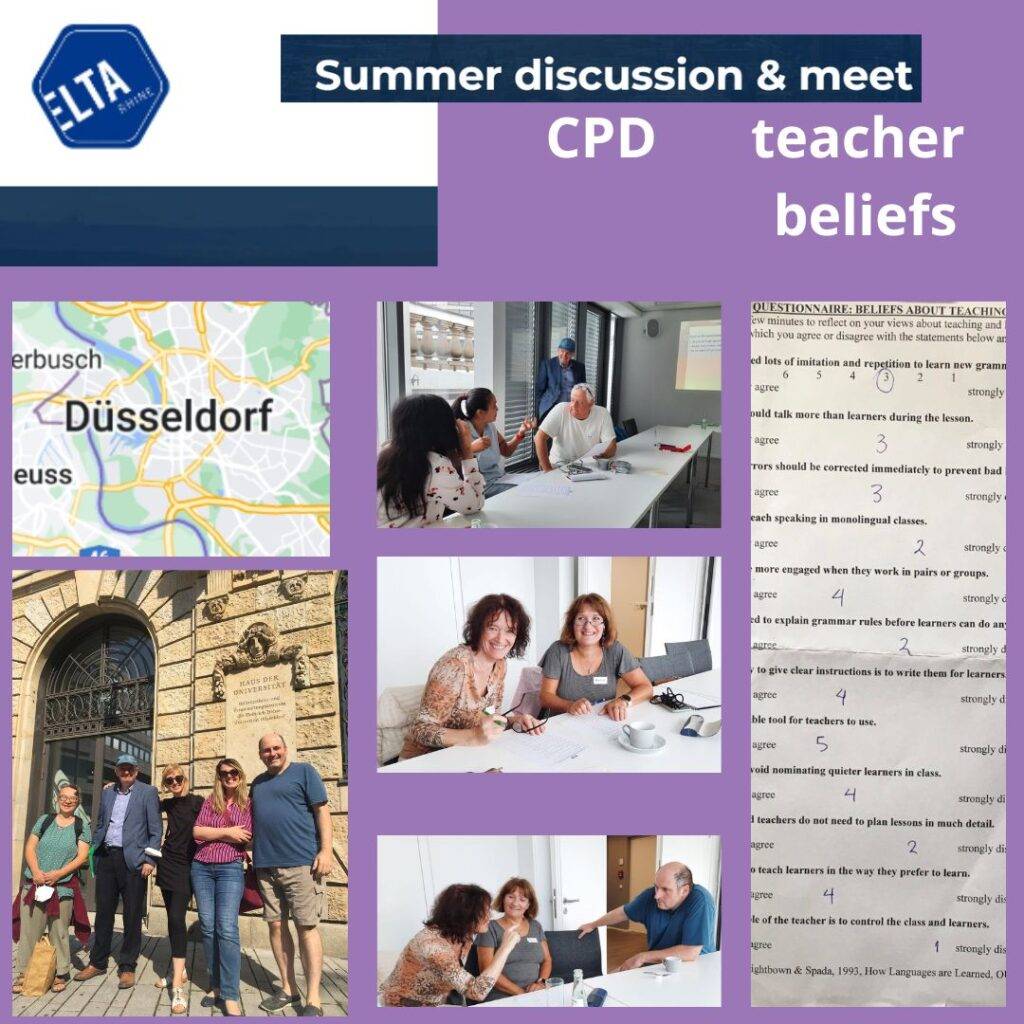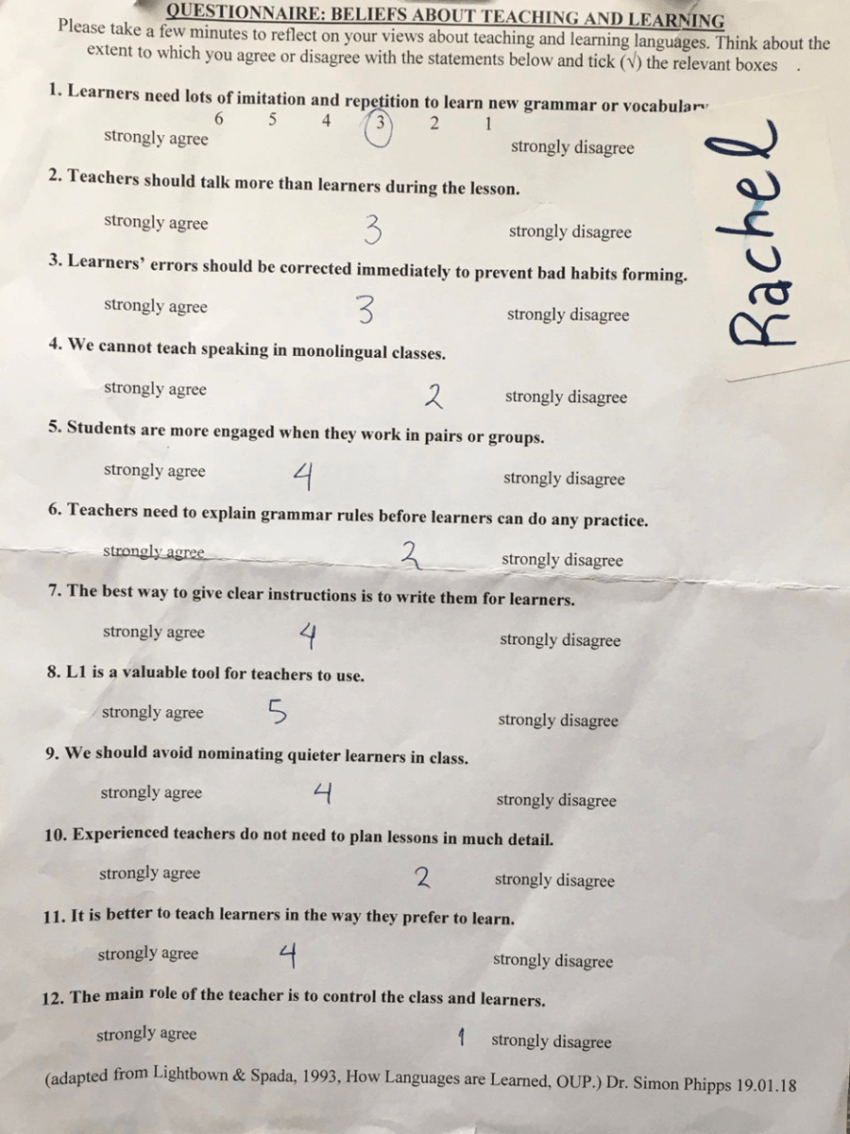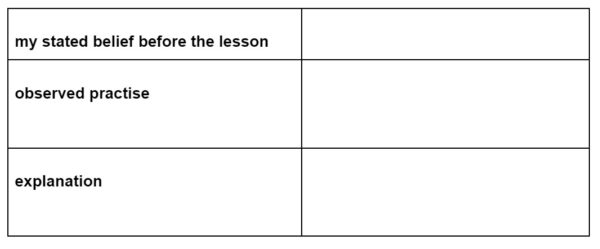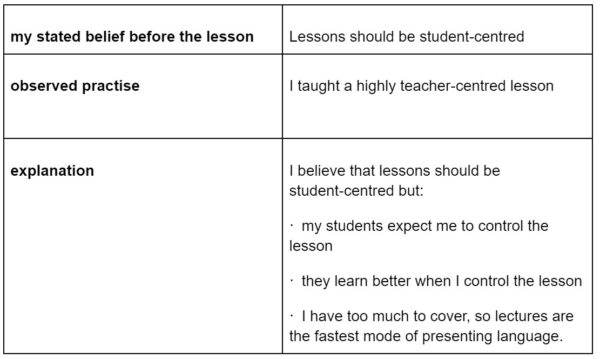
Written by:
Rachel Tsateri
On August 20th, I had the pleasure of attending the summer networking and discussion event in Dusseldorf, organized by ELTA Rhine. It was a wonderful opportunity to meet, collaborate and share best practices with ELT colleagues from different parts of Germany,
The day was split into two parts.
- Part 1 : Teacher Beliefs
- Part 2 : CPD Beyond the Pandemic
The speaker was Simon Phipps, centre director of Anatolia Training Institute. It is worth mentioning that Simon has a PhD in education with a focus on teacher beliefs, which was the topic of the first session.
Part 1: Teacher Beliefs
Why do we do what we do?
Simon began by highlighting the importance of uncovering our teaching beliefs. As he said, our beliefs are developed before we even start teaching, for instance while we are still at school or when we are learning a foreign language, and so they can be deep-rooted and hard to change. They are usually unconscious, but they tend to influence our teaching as well as filter any input we receive from teacher training. By uncovering our beliefs, we can understand and improve our practice.
Simon gave us this questionnaire. You can read my answers below:

Even if you didn’t attend the session, you can still do this exercise. Just follow these steps:
- Read the statements
- Circle one number
- Justify your answer
Tip: you might want to do this with a colleague. A discussion with a peer usually makes the process easier.
Let’s dig deeper
For example, let’s have a look at statement number two, which says:
‘Teachers should talk more than learners during a lesson’.
Perhaps you think that this is true. This implies that one of your teaching beliefs is that the teacher is an important source of input in the classroom. Therefore, students should take advantage of this opportunity to learn from the teacher.
If you chose that learners should be doing most of the talking, this means that you believe the teacher’s role is to maximise student talking time in order to provide students with opportunity to practise using the language with each other.
Finally, if you select a neutral answer like three or four, this probably means that you are more flexible; for instance you may believe it depends on the group or the lesson, as you’re not convinced that one of the two answers is correct.
Match or mismatch?
Another interesting point that Simon made was that sometimes our practices do not always reflect our stated belief, which may happen for several reasons. A way to explore this in relation to our teaching is by doing a self-observation task and completing this table:

Bonus point
Something that came up was that perhaps teachers need to make certain processes and decisions explicit to students in order to increase their motivation and awareness. For example, it might be useful to tell them why we are not correcting them during a fluency-based task and why we might correct more during an accuracy-based task. When they know the rationale behind our choices they might feel safer, i.e. they might trust us more as educators and also know what to expect.
Here’s an example that Simon provided us with:

Part 2: CPD Beyond the Pandemic
The C in CPD
Simon first invited us to think of what the C in CPD stands for. He said it could stand for:
- continued: implies it stopped at some point
- continuous: implies that it never stops
- continuing: implies that it may be interrupted because life gets in the way and then starts again
He then described CPD as…
- a process not a product
- mostly long term and cannot be achieved without pain or effort
- individual or social- collaborative
- aiming to improve the quality of our teaching and help us grow as professionals
- aiming to change our knowledge, skills and awareness, or beliefs, attitudes and values
But the ultimate purpose of CPD is to improve student learning
Simon then mentioned there are three different models of learning
- The Craft Model: learning from observing an expert, the ‘master of the craft’ (experiential knowledge)
- The Applied Science Model: learning from research and science (received knowledge)
- The Reflective Model: learning through an ongoing cycle of reflecting on both experiential and received knowledge.
For those who need help with reflection, Simon suggested the following structure:
- See it as a puzzle rather than a problem
- Think what you can do about it
- Once you do something about it, ask yourself what changes you noticed.
- What evidence do you have – how do you know that something has changed?
- Keep experimenting and reflecting until you are satisfied with the outcome.
Join us!
This event was free for all ELTA members. So why not join your local ELTA and attend the next face-to-face, hybrid or online event?


No Comments Yet